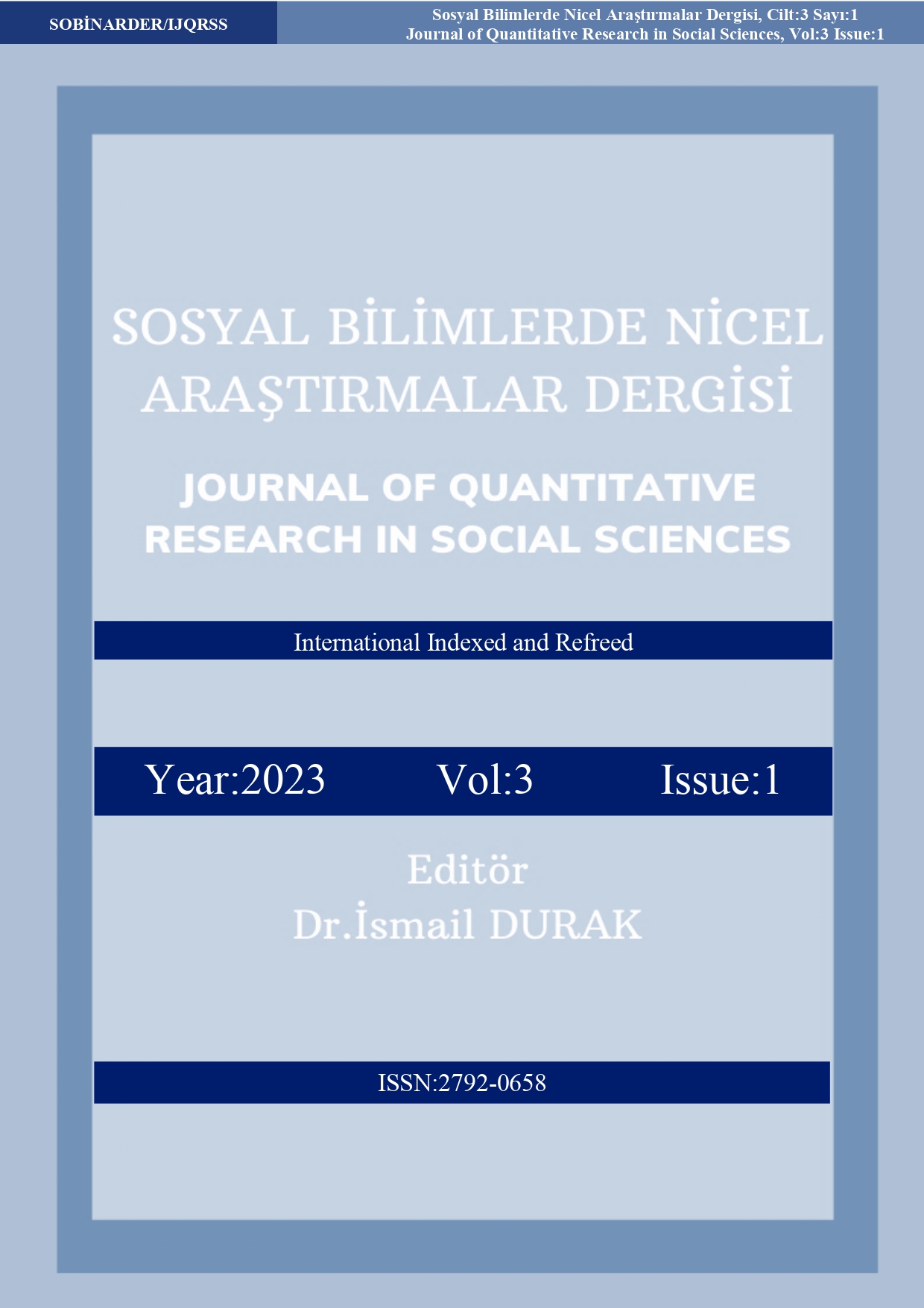The Effect of Entrepreneurs' Sector and Enterprise Type Preferences on Survival Rates: Evaluation in the Light of Secondary Data
Keywords:
New Venture, Survival in Startups, Entrepreneur Preference, Types of Commercial EnterprisesAbstract
The main purpose of this study is to evaluate how the preferences of the entrepreneurs in Turkey regarding the type of enterprise according to the sector and legal structure of the enterprise will affect the survival rate of the enterprise they have established. In addition, it is aimed to create a data source for new ventures and to offer suggestions about the ventures to be established. In this study, descriptive and explanatory research method was used. As a data collection method, document/record analysis was carried out. In the study, it was aimed to evaluate the data published in Turkey covering the entire universe. For this, official data published by the Turkish Statistical Institute (TUIK), the Union of Chambers and Commodity Exchanges of Turkey (TOBB) and the Ministry of Commerce between 2016 and 2022 were used. According to the findings of the study, the sector with the highest survival rate of enterprises between the years 2016-2022 is the other service activities sector, and the sector with the lowest is the electricity, gas, steam and air conditioning production and distribution sector. In addition, according to the findings, the type with the lowest rate of established-closed venture is the Limited Company. Entrepreneurs' making the right choice in choosing the sector in their new ventures will increase the survival rates of their ventures. In addition, the type of venture that entrepreneurs will choose for their new ventures will also affect their survival rates.
References
Agarwal, R., & Audretsch, D. B. (2001). Does entry size matter? The impact of the life cycle and technology on firm survival. The Journal of Industrial Economics, 49(1), 21-43. https://doi.org/10.1111/1467-6451.00136
Alvarez, C., Urbano, D., Coduras, A. & Ruiz‐Navarro, J. (2011). Environmental conditions and entrepreneurial activity: a regional comparison in Spain, Journal of Small Business and Enterprise Development, 18(1), 120-140. https://doi.org/10.1108/14626001111106460
Audretsch, D. B. (1991). New-firm survival and the technological regime. The review of Economics and Statistics, 441-450. Erişim Adresi: https://www.jstor.org/stable/pdf/2109568.pdf
Audretsch, D. B., & Mahmood, T. (1995). New firm survival: new results using a hazard function. The review of economics and statistics, 97-103. Erişim Adresi: https://www.jstor.org/stable/pdf/2109995.pdf
Audretsch, D. B. & Thurik, A. R. (Eds.). (1999). Innovation, industry evolution and employment. Cambridge University Press. Erişim Adresi: https://www.econstor.eu/bitstream/10419/85537/1/99068.pdf
Battal, A., & Erdoğmuş, N. (2011). Hukuki yolun yolsuzluğa alet edilmesine örnek: Sorumluluktan kaçmak için sermaye şirketi kurmayı tercih etmek. İş Ahlakı Dergisi, 4(1), 7-18. Erişim Adresi: https://isahlakidergisi.com/content/6-sayilar/7-4-cilt-1-sayi/m0034/battal.pdf
Caliendo, M., Fossen, F., & Kritikos, A. (2010). The impact of risk attitudes on entrepreneurial survival. Journal of Economic Behavior & Organization, 76(1), 45-63. https://doi.org/10.1016/j.jebo.2010.02.012
Cooper, A. C., Gimeno-Gascon, F. J. ve Woo, C. Y. (1994). Initial human and financial capital as predictors of new venture performance. Journal of business venturing, 9(5), 371-395. https://doi.org/10.1016/0883-9026(94)90013-2
Çubukçu, M. (2023). Asırlık işletmelerin uzun ömürlüğüne dair bir araştırma. International Journal of Management and Administration, 7 (13) , 1-20 . DOI: 10.29064/ijma.1149867
Eurostat (2008). NACE Rev. 2. Statistical classification of economic activities in the European Community.
Eurostat Methodologies and Working papers. Luxembourg: European Commission. Erişim Adresi: https://ec.europa.eu/eurostat/documents/3859598/5902521/KS-RA-07-015-EN.PDF
Fayganoğlu, P. (2019). Örtük bilgi ve örtük bilgi paylaşımının örgütler için yenilikçilik ve hayatta kalma açısından önemi. Journal of International Social Research, 12(63), 1068-1074 http://dx.doi.org/10.17719/jisr.2019.3298
Ghalayini, A.M. & Noble, J.S. (1996). The Changing Basis of Performance Measurement, International Journal of Operations & Production Management, Vol. 16 (8), 63-80. https://doi.org/10.1108/01443579610125787
Globerman, S., Shapiro, D., & Vining, A. (2005). Clusters and intercluster spillovers: their influence on the growth and survival of Canadian information technology firms. Industrial and Corporate Change, 14 (1), 27-60. https://doi.org/10.1093/icc/dth043
Honig, B. (1998). What determines success? Examining the human, financial, and social capital of jamaican microentrepreneurs. Journal of business venturing, 13(5), 371-394. https://doi.org/10.1016/S0883-9026(97)00036-0
Holtz-Eakin, D., Joulfaian, D., & Rosen, H. S. (1994). Sticking it out: Entrepreneurial survival and liquidity constraints. Journal of Political economy, 102(1), 53-75. https://doi.org/10.1086/261921
Huggins, R., Prokop, D., & Thompson, P. (2017). Entrepreneurship and the determinants of firm survival within regions: human capital, growth motivation and locational conditions. Entrepreneurship & Regional Development, 29(3-4), 357-389. https://doi.org/10.1080/08985626.2016.1271830
Mata, J., Portugal, P., & Guimaraes, P. (1995). The survival of new plants: Start-up conditions and post-entry evolution. International Journal of Industrial Organization, 13(4), 459-481. https://doi.org/10.1016/0167-7187(95)00500-5
Özdevecioğlu, M. & Karaca, M. (2015). Girişimcilik ve Girişimci Kişilik Kavram ve Uygulama. Konya: Eğitim Kitabevi.
Perani, G., & Cirillo, V. (2015). Matching industry classifications. A method for converting Nace Rev. 2 to Nace Rev. 1. WP-EMS Working Papers Series in Economics, Mathematics and Statistics.
Perren, L. (2000). Factors in the growth of micro‐enterprises (part 2): exploring the implications, Journal of Small Business and Enterprise Development, Vol. 7 No. 1, pp. 58-68. https://doi.org/10.1108/EUM0000000006805
Schnabl, E., & Zenker, A. (2013). Statistical classification of knowledge-intensive business services (KIBS) with NACE Rev. 2 (Vol. 25). Karlsruhe: Fraunhofer ISI.
Stivers, B. P., Covin, T. J., Hall, N. G., & Smalt, S. W. (1998). How nonfinancial performance measures are used. strategic finance, 79(8), 44. Erişim Adresi: https://www.proquest.com/docview/229751491?pq-origsite=gscholar&fromopenview=true
Sungur, O. (2014). İşletme kuluçkalarında firmalar arası ağbağlaşma faaliyetlerinin yeni kurulan firmaların hayatta kalabilirliği üzerine etkisi. Ege Academic Review, 14(2). Erişim Adresi: https://web.p.ebscohost.com/ehost/pdfviewer/pdfviewer?vid=0&sid=74fe3f04-e679-473b-b829-7cec53da8bb5%40redis
Terzibaş, A., Kavcar, B., & Mutlu, H. T. (2023) İşletme Başarısında Girişimcinin Bireysel Kaynakları. İksad Yayınevi. Erişim Adresi: https://iksadyayinevi.com/wp-content/uploads/2023/03/ISLETME-BASARISINDA-GIRISIMCININ-BIREYSEL-KAYNAKLARI.pdf
Ticaret Bakanlığı, (2023). Ticari işletmeler, ticaret şirketleri ve ticaret sicili uygulamaları hakkında bilgiler. Erişim Adresi: https://ticaret.gov.tr/ic-ticaret/sirketler/sirket-bilgiler Erişim tarihi: 21.05.2023
TOBB, (2023). Kurulan, Kapanan Şirket İstatistikleri. Erişim Adresi: https://www.tobb.org.tr/BilgiErisimMudurlugu/Sayfalar/KurulanKapananSirketistatistikleri.php Erişim Tarihi: 10.04.2023
TÜİK, (2023). Türkiye Geneli NACE Rev. 2 Sektör Bazında Toplam Girişim Sayıları. Erişim adresi: https://biruni.tuik.gov.tr/medas/?kn=145&locale=tr Erişim tarihi: 20.05.2023
Vedula, S., & Kim, P. H. (2019). Gimme shelter or fade away: The impact of regional entrepreneurial ecosystem quality on venture survival. Industrial and Corporate Change, 28(4), 827-854. https://doi.org/10.1093/icc/dtz032
Venkatraman, N., & Ramanujam, V. (1986). Measurement of business performance in strategy research: A comparison of approaches. Academy of management review, 11(4), 801-814. https://doi.org/10.5465/amr.1986.4283976
Downloads
Published
How to Cite
Issue
Section
License
Copyright (c) 2023 Journal of Quantitative Research in Social Sciences

This work is licensed under a Creative Commons Attribution-NonCommercial 4.0 International License.
Telif hakkı hakkında










